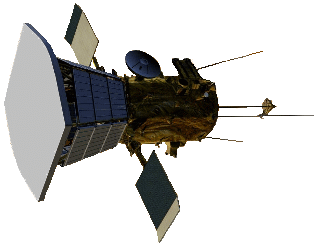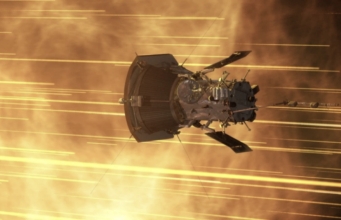  On a mission to 'touch the Sun', NASA's Parker Solar Probe became the first spacecraft to fly through the corona – the Sun's upper atmosphere – in 2021. With every orbit bringing it closer, fitted with a thick heat shield, the probe faces intense heat and radiation to give us unparalleled observations, visiting the only star we can study up close!
On a mission to 'touch the Sun', NASA's Parker Solar Probe became the first spacecraft to fly through the corona – the Sun's upper atmosphere – in 2021. With every orbit bringing it closer, fitted with a thick heat shield, the probe faces intense heat and radiation to give us unparalleled observations, visiting the only star we can study up close!
Parker will fly more than seven times closer to the Sun than any spacecraft has before. Over seven years, the spacecraft will complete 24 orbits around the Sun. At its closest, the spacecraft will come within about 6.2 million kilometers of the Sun. During each pass, the spacecraft picks up more speed. In 2018, soon after its launch, the probe became the fastest human-made object ever launched, and by 2024 it will reach an incredible 688,000 kilometres per hour. At such a speed, one could travel from Vancouver to Halifax in just 20 seconds! The Parker Solar Probe's first mission was to reach the corona. The data collected will help scientists forecast how solar flares — eruptions from the sun's surface — will impact Earth, and answer questions about the solar wind, the stream of particles and radiation constantly emitted by the sun. A particularly threatening type of solar eruption is called a coronal mass ejection, or CME. These occur when the sun ejects a mass of super hot gas, called plasma. These occurrences can wreak havoc on our power grids, navigation and communication networks. This happened in Quebec in 1989; during the 12-hour blackout that followed, millions of people suddenly found themselves in dark office buildings and underground pedestrian tunnels, and in stalled elevators. In less than two minutes, the entire Quebec power grid lost power.  The spacecraft has made more than 17 orbits around the sun, allowing the craft to boost its speed each time it passes by the massive gravity well of the sun. At such high speed, the spacecraft begins a new orbit every three months, allowing its instruments to collect information about the solar environment.
The spacecraft has made more than 17 orbits around the sun, allowing the craft to boost its speed each time it passes by the massive gravity well of the sun. At such high speed, the spacecraft begins a new orbit every three months, allowing its instruments to collect information about the solar environment. Scientists want to know why the solar wind accelerates after it leaves the sun, reaching up to 3.2 million km/h. They want to understand why the corona, which reaches over one million degrees Celsius, is so much hotter than the sun's surface, at only 5,500 degrees Celsius. Just outside the corona, the spacecraft is exposed to massive heat and radiation. In September 2022 it flew through one of the most powerful coronal mass ejections ever recorded. The craft remains in great shape, thanks to a 11-cm-thick carbon heat shield that's pointed at the sun. The shield itself heats up to about 1,400 degrees Celsius, allowing the instruments to work at room temperature. |